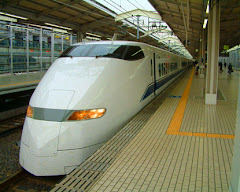By Paul Marin
April 2009
I had the honor of attending the Obama press conference. It was very exciting to hear the President set a new agenda for transportation.
The President laid out two priorities: Fixing existing routes to reduce transit times and constructing new world-class high speed rail lines.
Here are a couple key quotes from the event. I am not a reporter, so these should not be treated as direct quotes, but they give a good feel for the tone of the event:
Secretary LaHood: There will be a time when we look back on this day as a game changer; A time that we got serious about public transit for all Americans.
President Obama: We are making a down payment on the economy of the future. We need to start a transportation system equal to the needs of the 21st century. High-speed rail has been happening to decades, the problem isthat it is happening in other places. There is no reason that we can't do this.
More details:
http://www.fra.dot.gov/us/press-releases/226President Obama, Vice President Biden, Secretary LaHood Call for U.S. High Speed Passenger Trains
Contact: Jill Zuckman Telephone: (202) 366-4570
Thursday, April 16, 2009 (Washington, DC)
President Obama, Vice President Biden, Secretary LaHood Call for U.S. High Speed Passenger Trains
Vision for a New Era in Rail Entails Clean, Energy-Efficient Option for Travelers
President Barack Obama, along with Vice President Biden and SecretaryLaHood, announced a new U.S. push today to transform travel in America,c reating high-speed rail lines from city to city, reducing dependence oncars and planes and spurring economic development.
The President released a strategic plan outlining his vision for high speedrail in America. The plan identifies $8 billion provided in the ARRA and $1billion a year for five years requested in the federal budget as a downpayment to jump-start a potential world-class passenger rail system and sets the direction of transportation policy for the future.
The strategic plan will be followed by detailed guidance for state and local applicants. By late summer, the Federal Railroad Administration will begin awarding the first round of grants. Additional funding for long-term planning and development is expected from legislation authorizing federal surface transportation programs.
The report formalizes the identification of ten high-speed rail corridorsas potential recipients of federal funding. Those lines are: California,Pacific Northwest, South Central, Gulf Coast, Chicago Hub Network, Florida,Southeast, Keystone, Empire and Northern New England.
Also, opportunities exist for the Northeast Corridor from Washington to Boston to compete for funds to improve the nation's only existing high-speed rail service.
With a boost from the American Recovery and Reinvestment Act, the Obama administration launched a competitive process to drive local communities todevelop their high-speed rail potential. The President, Vice President andSecretary of Transportation are urging states and local communities to put together plans for a network of 100 mile to 600 mile corridors, which will compete for the federal dollars.
The merit-driven process will result in federal grants as soon as late summer 2009. --
President Obama's vision for high-speed rail mirrors that of President Eisenhower, the father of the Interstate highway system, which revolutionized the way Americans traveled. Now, high-speed rail has the potential to reduce U.S. dependence on foreign oil, lower harmful carbon emissions, foster new economic development and give travelers more choices when it comes to moving around the country.
"My high-speed rail proposal will lead to innovations that change the waywe travel in America. We must start developing clean, energy-efficient transportation that will define our regions for centuries to come," said President Obama.
"A major new high-speed rail line will generate many thousands of construction jobs over several years, as well as permanent jobs for rail employees and increased economic activity in the destinations these trains serve. High-speed rail is long-overdue, and this plan lets American travelers know that they are not doomed to a future of long linesat the airports or jammed cars on the highways."
"Today, we see clearly how Recovery Act funds and the Department of Transportation are building the platform for a brighter economic future -they're creating jobs and making life better for communities everywhere," said Vice President Biden. "Everyone knows railways are the best way to connect communities to each other, and as a daily rail commuter for over 35 years, this announcement is near and dear to my heart.
Investing in ahigh-speed rail system will lower our dependence on foreign oil and the bill for a tank of gas; loosen the congestion suffocating our highways andskyways; and significantly reduce the damage we do to our planet." "President Obama's vision of robust, high-speed rail service offersAmericans the kind of travel options that throughout our history have contributed to economic growth and enhanced quality of life," said Secretary LaHood.
"We simply can't build the economy of the future on thetransportation networks of the past." The plan identifies two types of projects for funding. One would create new corridors for world-class high-speed rail like the kind found in Europe and Japan.
Another would involve making train service along existing rail lines incrementally faster. Under the plan, high-speed rail development will advance along three funding tracks:
Individual Projects-- Providing grants to complete individual projects that are "ready to go" with completed environmental and preliminary engineering work with an emphasis on near term job creation. Eligible projects include acquisition, construction of or improvements to infrastructure, facilities and equipment.
Corridor programs-- Developing entire phases or geographic sections of high-speed rail corridors that have completed corridor plans, environmental documentation and have a prioritized list of projects to help meet the corridor objectives.
Planning--Entering into cooperative agreements for planning activities (including development of corridor plans and State Rail Plans) using non-American Recovery and Reinvestment Act (ARRA) appropriations funds. This third approach is intended to help establish a structured mechanism and funding stream for future corridor development activities.





